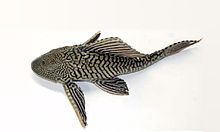Loricarioidea
Appearance
| Loricarioidea Temporal range: Possible Cenomanian record[2]
| |
|---|---|

| |
| Pterygoplichthys sp. | |
| Scientific classification | |
| Domain: | Eukaryota |
| Kingdom: | Animalia |
| Phylum: | Chordata |
| Class: | Actinopterygii |
| Order: | Siluriformes |
| Superfamily: | Loricarioidea Rafinesque, 1815 |
| Families | |
|
( Amphiliidae )Astroblepidae Callichthyidae Loricariidae Nematogenyiidae Scoloplacidae Trichomycteridae | |
Loricarioidea is a
Amphiliidae. This superfamily, including Amphiliidae, includes about 156 genera and 1,187 species.[3]
Taxonomy
Loricarioidea is traditionally considered a part of Siluroidei, a clade of all catfishes excluding
Malapteruridae.[4] It is disputed whether Loricarioidea or Diplomystidae are the most basal group of catfish, with molecular studies favoring the former while morphological studies favor the latter.[5]
The earliest known definitive loricaroid is the
fossil record of Loricariidae (and Siluriformes as a whole).[2] However, this taxon might represent a juvenile obaichthyid lepisosteiform, possibly a junior synonym of Obaichthys,[6] though this has been disputed based on the complete ossification of the bones indicating full maturity and the absence of important holostean characters.[7]
Loricarioidea is currently diagnosed by the derived presence of a reduced
gas bladder, encapsulated in expansions of the parapophysis of the first vertebrae, and of odontodes, small dermal denticles.[8] Amphiliidae is the most basal group in Loricarioidea.[3] In some older sources, Amphiliidae is not even included in this classification.[9] Based on morphologically evidence, Trichomycteridae and Nematogenyiidae diverge first; these two families are probably sister groups.[3] This relationship was neither supported nor rejected by molecular evidence.[4] Next, the order of divergence is probably Callichthyidae, then Scoloplacidae, and then Astroblepidae and Loricariidae.[3][4] A trend in increasingly complex jaw morphology can be seen in this superfamily, which may have allowed for the great diversification of the Loricariidae, which have the most advanced jaws.[9]
Distribution and habitat
These fish are found in
Neotropics, inhabiting South America, Panama, and Costa Rica. Most species inhabit stream habitats or pools; water in these habitats tends to move relatively quickly.[9] Loricariids and Astroblepids have adapted to this with suckermouths that allow them to cling to surfaces. Astroblepids even have the ability to climb up waterfalls.[3]
Description
Like other catfish, loricarioidean catfish tend to have whiskers (except within the family Loricariidae). Fish in this group can be naked or, in the case of Callichthyids, Scoloplacids, and Loricariids, armored with bony plates.odontodes on their body and fin rays.[9] In Loricariids, these odontodes on their gill cover can be extended outwards.[9] Astroblepids may use their odontodes as a sensory organ.[10]
Ecology
Loricarioidea is a very diverse
candirú) and wood-eating species (Panaque).[9][11] Loricariidae is by far the most successful and diverse family with approximately 700 species (and new species being discovered each year), and is the most species-rich family in the entire order.[3]
References
- ^ ISSN 0097-3157.
- ^ .
- ^ ISBN 0-471-25031-7.
- ^ PMID 16876440.
- ^ .
- .
- .
- ^ Reis, Roberto E. (1998-05-14). "Callichthyidae. Armored Catfishes". Tree of Life Web Project. Retrieved 2007-07-04.
- ^ JSTOR 2413111.
- ]
- .
